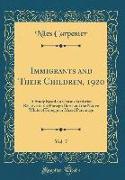Immigrants and Their Children, 1920, Vol. 7
BücherAngebote / Angebote:
Excerpt from Immigrants and Their Children, 1920, Vol. 7: A Study Based on Census Statistics Relative to the Foreign Born and the Native White of Foreign or Mixed ParentageWhen modern censuses began, the enumeration unit was the family or household, and the population was determined from the number of households and the number of persons in each. But for two generations the enumeration unit has been the individual, to whom a line on the schedule or a separate card or sheet is devoted and about whose characteristics many questions are asked. The answers state physical traits, like sex, age, and race, educational traits, like illiteracy or ability to speak English, and economic traits, like occupation or ownership of the home. Most of the tables which result from assembling the answers to these questions are necessarily underlain by the idea that the individual is, at least for census purposes, the unit out of which society or the State is constructed.More recently this one-sided individualism of the census tabulation has been supplemented by special studies of certain social groups. This began with the volume on Indians in the United States, which was a part of the census of 1890, and which was suggested, if not made necessary, by the fact that the Indians on reservations were then enumerated for the first time and apart from the general population census. The tendency was continued at the census of 1900 by supplementary studies of the census statistics of the negro and the negro farmer, of the family, and of teachers as an occupational class. The census of 1910 was left incomplete through the exhaustion of the appropriation and the only elaborate study of a social group which resulted from it was one on the negroes in the United States.For the census of 1920 a series of supplementary monographs was planned, some of which at least will be of the type described. The present study dealing with the foreign-born population and their American-born children is one of them.The group which Doctor Carpenter studies is very heterogeneous. In fact, our foreign-born population is a class the members of which have only one common characteristic and that a negative one, namely, that its members were not born in the United States. This heterogeneity has proved a serious obstacle to the analysis of the group. Indeed no conclusion stands out on the following pages more clearly than this, that little significant study of the statistics of the foreign born can be made until they are divided into more homogeneous groups by classifying them according to the country or district of birth.About the PublisherForgotten Books publishes hundreds of thousands of rare and classic books. Find more at www.forgottenbooks.comThis book is a reproduction of an important historical work. Forgotten Books uses state-of-the-art technology to digitally reconstruct the work, preserving the original format whilst repairing imperfections present in the aged copy. In rare cases, an imperfection in the original, such as a blemish or missing page, may be replicated in our edition. We do, however, repair the vast majority of imperfections successfully, any imperfections that remain are intentionally left to preserve the state of such historical works.
Folgt in ca. 10 Arbeitstagen
